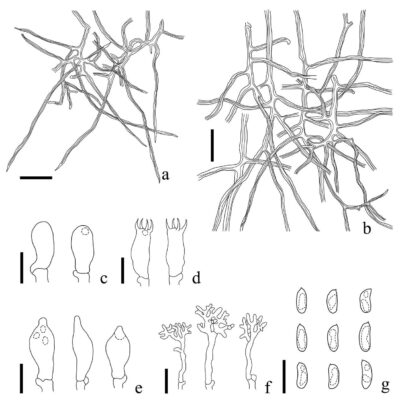Fungalpedia – Note 377, Neodatronia
Neodatronia B.K. Cui, Hai J. Li & Y.C. Dai
Citation when using this data: Tibpromma et al. 2024 (in prep.) – Fungalpedia, Macrofungi.
Index Fungorum, Facesoffungi, MycoBank, GenBank, Fig. 1
Classification: Polyporaceae, Polyporales, Incertae sedis, Agaricomycetes, Agaricomycotina, Basidiomycota, Fungi.
Li et al. (2014) suggested the creation of the genus Neodatronia to include two species, Neodatronia gaoligongensis (the type species) and N. sinensis, based on phylogenies of ITS, LSU, and RPB2 analyses and morphological studies. Neodatronia is characterized by resupinate basidiocarps, annual, pore surface white, cream to pale brown; moderate to small, round to angular pores; subiculum yellowish brown to cinnamon, corky; generative hyphae with clamp connections, skeletal hyphae usually dominating, pale brown to brown; dendrohyphidia present in the hymenium and dissepiment edges, cystidia absent; hyaline basidiospores, cylindrical, smooth, thin-walled, IKI–, CB– (Li et al. 2014). Neodatronia usually grows on angiosperm wood and causes white rot (Li et al. 2014). No further species have been introduced to this genus which remains two species in Neodatronia.
Type species: Neodatronia gaoligongensis B.K. Cui, Hai J. Li & Y.C. Dai
Other accepted species: Species Fungorum – search Neodatronia
Figure 1 – Neodatronia gaoligongensis. a Skeletal hypha from trama. b Skeletal hyphae from subiculum. c Basidioles. d Basidia. e Cystidioles. f Dendrohyphidia. g Basidiospores. Scale bars: a, b = 20 µm, c–g = 10 µm. Redrawn from Li et al. (2014).
Reference
Entry by
Du TY, Center for Yunnan Plateau Biological Resources Protection and Utilization, College of Biological Resource and Food Engineering, Qujing Normal University, Qujing, Yunnan 655011, China; Center of Excellence in Fungal Research, Mae Fah Luang University, Chiang Rai 57100, Thailand; School of Science, Mae Fah Luang University, Chiang Rai 57100, Thailand.
(Edited by Saowaluck Tibpromma, Samaneh Chaharmiri-Dokhaharani, & Achala R. Rathnayaka)
Published online 25 November 2024
